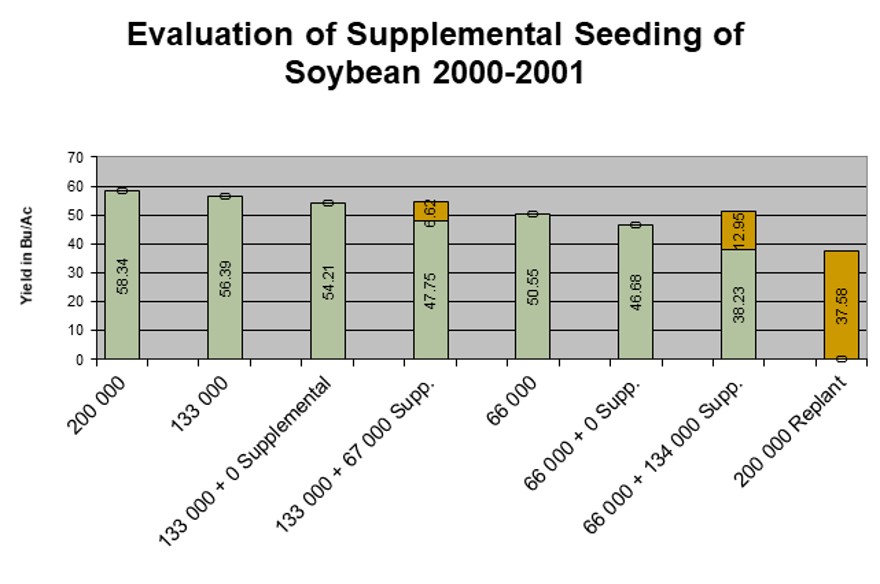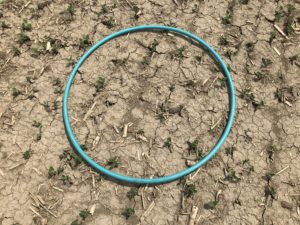Soybeans are prone to poor plant establishment because the seedling must pull the cotyledon seed leaves through the ground to emerge. Plant stand reductions are rarely uniform, which makes the decision to replant difficult. Do not assess a poor soybean stand too quickly, since more seedlings may still emerge. In 2020 we have seen soybeans emerge 40 days after planting. Amazingly, many April planted soybeans that suffered from extreme cold now have excellent plant stands. Often once a crack is visible on the soil surface down the row a sufficient number of seedlings will survive. See Picture #1.

A plant reduction of up to 50% does not need replanting if plant loss is uniform and the stand is healthy. Numerous studies and field experience have demonstrated that keeping an existing stand is often more profitable than replanting. Replanting gives no guarantee of a perfect stand. Keep in mind that normal seeding rates include a margin of safety to ensure emergence of an adequate stand.
Understanding the cause of the low plant population is essential to know if replanting is necessary. These include soil crusting, herbicide injury, frost, hail, insects and diseases. For instance, if seed corn maggot has reduced the stand many of the surviving seedlings will also be partially destroyed. Replanting in that case is usually the correct decision because the remaining plants are also weakened, and an insecticide seed treatment is necessary when replanting. In a wet year, damping-off may be the issue. In this situation consider the use of a variety resistant to Phytophthora plus a fungicide seed treatment when replanting.
Evaluation Stands:
Taking a hula hoop and writing on the side a few common populations based on the number of plants counted in the hoop is a quick way to get the job done. See picture #2.

Use Table #1 below to determine the populations based on the size of the hoop. Alternatively use the “Bean Cam” app on your smart phone to get a plant stand count. https://ipcm.wisc.edu/apps/beancam/
Table 1 – Plant Populations Using the Hula Hoop
| Factor by which to multiply the number of plants within the hoop to equal: | ||
| Inside Diameter of Hoop in cm (in) | Plants per Hectare | Plants per Acre |
| 91 (36) | 15 385 | 6 165 |
| 84 (33) | 18 182 | 7 334 |
| 76 (30) | 22 222 | 8 874 |
| 69 (27) | 27 027 | 10 956 |
| 61 (24) | 34 483 | 13 865 |
Thickening Stands:
If replanting is required, there is no need to destroy the existing stand of soybeans. Simply plant the same variety on top of the existing stand. Replanting alongside the established seedlings to thicken the existing stand only improves yields when the stand is very poor. The replanted seedlings are so far behind in development that they are unable to compete with even a thin original stand. Research conducted in Indiana a number of years ago showed that thickening a stand of more than 66 000 plants per acre did not add significant yield. By running a 30” row planter on top of an existing 7.5” stand approximately 2.5 bu/ac are lost simply by tramping. Destroying the original stand and replanting resulted in the lowest yield.

Semmel, T., E.P. Christmas, and G.C. Marini. An evaluation of supplemental planting to increase marginal stands of narrow row soybean using a 30 inch planter.
Ontario Recommendations
Soybeans have a tremendous ability to compensate for missing plants. Existing plants will branch and produce more pods to fill in gaps. The uniformity of the existing crop is more important than having a high population. Soybean plants can fill spaces up to 30 cm (12 inches) within or between rows with relatively little yield reduction. Research has shown that a 60% stand can provide 95+ % yield potential under good growing conditions. This will depend on the remaining plants being healthy and being distributed evenly throughout the field. It’s also important that plants be kept free of weed competition or yield reductions will occur. Since thin stands are rarely uniform, field experience has shown an average plant stand of more than 100 000 plants/acre should not be thickened or replanted. This is for lighter soils and high yield environments A stand of 100 000 looks very thin at this time of year (picture #3) but try to imagine them at 3 feet tall when they need some space.

Heavier clay soils and lower yield environments will require more plants per acre for good yields. Ontario experience has shown that a minimum average number of plants on heavy clay soils is approximately 120 000 plants/ac.
Comments are closed.